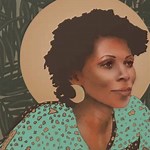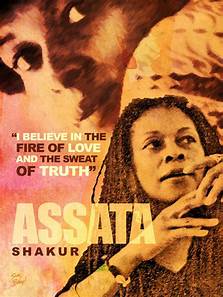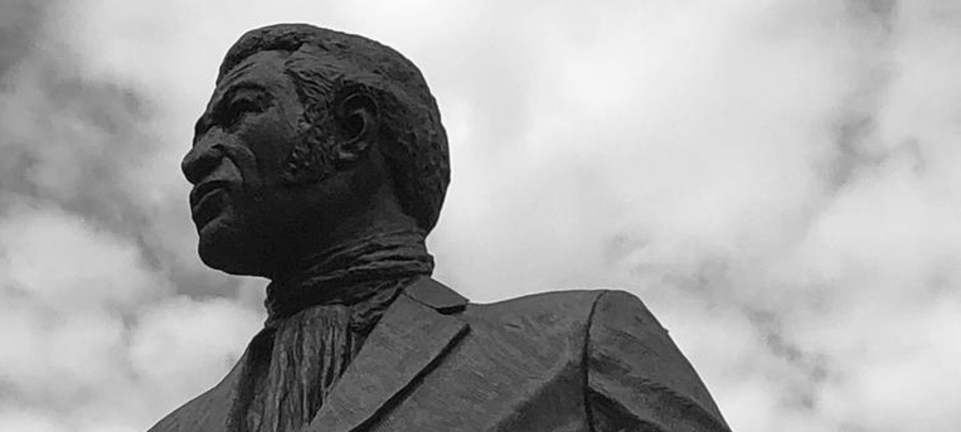BLM 2.0
What We Believe
Contact Us
Reparations
Fanon Forum
Afrofuturism
BLOG
lllll
Education
Environment
Justice
Economy
Defense
Foreign Policy
Health Care
Science/Technology
Culture
Rights
Home
Government
Legislative
Executive
Judicial
Submissions
Program Updates
The Vesey Republic
April 2, 2022 - June, 19, 2023
Call for a Chesimard/Shakur Draft Program
A Majority Black-Led Nation-State
Draft Program
Assata Shakur
Denmark Vesey
Denmark Vesey's
Notebook
Reparations
Joanna Chesimard / Assata Shakur - A Journey From Catholic High School Student to the Black Liberation Army
Assata Shakur was born Joanne Deborah Byron, in Flushing, Queens, New York City, on July 16, 1947. She moved with her grandparents to Wilmington, North Carolina. After elementary school, Shakur moved back to Queens to live with her mother and stepfather She often ran away, staying with strangers and working for short periods of time, until she was taken in by her mother's sister Evelyn A. Williams, a civil rights worker who lived in Manhattan. Shakur has said that her aunt was the heroine of her childhood, as she was constantly introducing her to new things. She said that her aunt was "very sophisticated and knew all kinds of things. She was right up my alley because I was forever asking all kinds of questions. I wanted to know everything." Williams often took the girl to museums, theaters, and art galleries.
Shakur converted to Roman Catholicism as a child and attended the all-girls Cathedral High School, for six months before transferring to public high school. She attended for a while before dropping out and later earned a General Educational Development (GED) degree. Often there were few or no other black students in her Catholic high school class.
Shakur later wrote that teachers seemed surprised when she answered a question in class, as if not expecting black people to be intelligent and engaged. She said she was taught a sugar-coated version of history that ignored the oppression suffered by people of color, especially in the United States. In her autobiography, she wrote: "I didn’t know what a fool they had made out of me until I grew up and started to read real history"
Shakur attended Borough of Manhattan Community College (BMCC) and then the City College of New York (CCNY) in the mid-1960s, where she became involved in many political activities, civil rights protests, and sit-ins. She was arrested for the first time—with 100 other BMCC students—in 1967, on charges of trespassing. The students had chained and locked the entrance to a college building to protest the low numbers of black faculty and the lack of a black studies program. In April 1967, she married Louis Chesimard, a fellow student-activist at CCNY. Their married life ended within a year; they divorced in December 1970. In her 320-page memoir, Shakur gave one paragraph to her marriage, saying that it ended over their differing views of gender roles.
After graduation from CCNY, Shakur moved to Oakland, California, where she joined the Black Panther Party (BPP). In Oakland, Shakur worked with the BPP to organize protests and community education programs.
After returning to New York City, Shakur led the BPP chapter in Harlem, coordinating the Free Breakfast Program for children, free clinics, and community outreach. But she soon left the party, disliking the macho behavior of the men and believing that the BPP members and leaders lacked knowledge and understanding of United States black history. Shakur joined the Black Liberation Army (BLA), an offshoot whose members were inspired by the Vietcong and the Algerian independence fighters of the Battle of Algiers. They mounted a campaign of guerilla activities against the U.S. government, using such tactics as planting bombs, holding up banks, and murdering drug dealers and police.
She began using the name Assata Olugbala Shakur in 1971, rejecting Joanne Chesimard as a "slave name". Assata is a West African name, derived from the Arabic name Aisha, said to mean "she who struggles", while Shakur means "thankful one" in Arabic. Olugbala means "savior" in Yoruba. She identified as an African and felt her old name no longer fit: "It sounded so strange when people called me Joanne. It really had nothing to do with me. I didn’t feel like no Joanne, or no negro, or no amerikan. I felt like an African woman".
Beginning in 1971, Shakur was allegedly involved in several incidents of assault and robbery, in which she was charged or identified as wanted for questioning, including attacks on New York City police and bank robberies in the area.
On April 6, 1971, Shakur was shot in the stomach during a struggle with a guest at the Statler Hilton Hotel in Midtown Manhattan. According to police, Shakur knocked on the door of a guest's room, asked "Is there a party going on here?", then displayed a revolver and demanded money. In 1987, Shakur confirmed to a journalist that there was a drug connection in this incident but refused to elaborate.
She was booked on charges of attempted robbery, felonious assault, reckless endangerment, and possession of a deadly weapon, then released on bail. Shakur is alleged to have said that she was glad that she had been shot; afterward, she was no longer afraid to be shot again.
Following an August 23, 1971, bank robbery in Queens, Shakur was sought for questioning. A photograph of a woman (who was later alleged to be Shakur) wearing thick-rimmed black glasses, with a high hairdo pulled tightly over her head, and pointing a gun, was widely displayed in banks. The New York Clearing House Association paid for full-page ads displaying material about Shakur.[28] In 1987, when asked in Cuba about police allegations that the BLA gained funds by conducting bank robberies and theft, Shakur responded, "There were expropriations, there were bank robberies."
On December 21, 1971, Shakur was named by the New York City Police Department as one of four suspects in a hand grenade attack that destroyed a police car and injured two officers in Maspeth, Queens. When a witness identified Shakur and Andrew Jackson from Federal Bureau of Investigation (FBI) photographs, a 13-state alarm was issued three days after the attack. Law enforcement officials in Atlanta, Georgia, said that Shakur and Jackson had lived together in Atlanta for several months in the summer of 1971.
Shakur was wanted for questioning for wounding a police officer on January 26, 1972, who was attempting to serve a traffic summons in Brooklyn.[36] After an $89,000 Brooklyn bank robbery on March 1, 1972, a Daily News headline asked: "Was that JoAnne?" Shakur was identified as wanted for questioning after a September 1, 1972, bank robbery in the Bronx. Based on FBI photographs, Monsignor John Powis alleged that Shakur was involved in an armed robbery at Our Lady of the Presentation Church in Brownsville, Brooklyn, on September 14, 1972.
In 1972, Shakur became the subject of a nationwide manhunt after the FBI alleged that she led a Black Liberation Army cell that had conducted a "series of cold-blooded murders of New York City police officers." The FBI said these included the "execution style murders" of New York City Police Officers Joseph Piagentini and Waverly Jones on May 21, 1971, and NYPD officers Gregory Foster and Rocco Laurie on January 28, 1972. Shakur was alleged to have been directly involved with the Foster and Laurie murders and involved tangentially with the Piagentini and Jones murders.
Some sources identify Shakur as the de facto head of the BLA after the arrest of co-founder Dhoruba Moore. Robert Daley, Deputy Commissioner of the New York City Police, for example, described Shakur as "the final wanted fugitive, the soul of the gang, the mother hen who kept them together, kept them moving, kept them shooting". Years later, some police officers argued that her importance in the BLA had been exaggerated by the police. One officer said that they had created a "myth" to "demonize" Shakur because she was "educated", "young and pretty".
As of February 17, 1972, when Shakur was identified as one of four BLA members on a short trip to Chattanooga, Tennessee, she was wanted for questioning (along with Robert Vickers, Twyman Meyers, Samuel Cooper, and Paul Stewart) in relation to police killings, a Queens bank robbery, and the grenade attack on police. Shakur was reported as one of six suspects in the ambushing of four policemen—two in Jamaica, Queens, and two in Brooklyn—on January 28, 1973.
On April 16, 1981, Shakur was allegedly in the back seat of a van connected with a burglary. After the vehicle was pulled over, two men stepped out of the vehicle and opened fire on NYPD officers John Scarangella and Richard Rainey. The two men were charged with the murder of Officer Scarangella and attempted murder of Officer Rainey.
By June 1973, an apparatus that would become the FBI's Joint Terrorism Task Force (JTTF) was issuing nearly daily briefings on Shakur's status and the allegations against her.
According to Cleaver and Katsiaficas, the FBI and local police "initiated a national search-and-destroy mission for suspected BLA members, collaborating in stakeouts that were the products of intensive political repression and counterintelligence campaigns like NEWKILL". They "attempted to tie Assata to every suspected action of the BLA involving a woman". The JTTF would later serve as the "coordinating body in the search for Assata and the renewed campaign to smash the BLA", after her escape from prison. After her capture, however, Shakur was not charged with any of the crimes for which she was purportedly the subject of the manhunt.
Shakur and others claim that she was targeted by the FBI's COINTELPRO as a result of her involvement with the black liberation organizations. Specifically, documentary evidence suggests that Shakur was targeted by an investigation named CHESROB, which "attempted to hook former New York Panther Joanne Chesimard (Assata Shakur) to virtually every bank robbery or violent crime involving a black woman on the East Coast". Although named after Shakur, CHESROB (like its predecessor, NEWKILL) was not limited to Shakur.
Years later when she was living in Cuba, Shakur was asked about the BLA's alleged involvement in the killings of police officers. She said, "In reality, armed struggle historically has been used by people to liberate themselves... But the question lies in when do people use armed struggle... There were people [in the BLA] who absolutely took the position that it was just time to resist, and if black people didn't start to fight back against police brutality and didn't start to wage armed resistance, we would be annihilated."
There were lights and sirens. Zayd was dead. My mind knew that Zayd was dead. The air was like gold glass. Huge bubbles rose and burst. Each one felt like an explosion in my chest. My mouth tasted like blood and dirt. The car spun around me and then something like sleep overtook me. In the background I could hear what sounded like gunfire. But I was fading and dreaming.
Suddenly, the door flew open and I felt myself being dragged out onto the pavement. Pushed and punched, a foot upside my head, a kick in the stomach. Police were everywhere. One had a gun to my head.
"Which way did they go?" he was shouting. "Bitch, you better open your goddamn mouth or I'll blow you goddamn head off!"
I nodded my head across the highway. I was sure that nobody had gone that way. A few of the cops were off and running.
One pig said, "We oughta finish her off." But the others were all busy around the car, searching it. They were pulling and prodding. "Ya find the gun?" they kept asking each other. Later, one of them asked another, "Should we put'er in the car?"
"Naw. Let'er lay in the gutter where she belongs. Just get'er out of the way." I felt myself being dragged by the feet across the pavement. My chest was on fire. My blouse was purple with blood. I was convinced that my arm had been shot off and was hanging inside my shirt by a few strips of flesh. I could not feel it.
Finally the ambulance came and they moved me into it. Being moved was agony, but the blankets were worth it. I was so cold. The medics examined me. I tried to talk, but only bubbles came out. I was foaming at the mouth.
Where's she hit?" they asked each other as if I wasn't there. They concluded their examination. I was relieved. "Let's move it," said one of them. "O.K., but wait a minute," said the driver and he got out. "Hit twice," I heard him say. "We gotta wait." The driver slammed the door.
He said something else but I didn't understand it. Time passed. I was floating off again. It felt so weird, like a dream, a nightmare. More time passed. It seemed like forever. I was in and out.
A rough voice asked, "Is she dead yet?" I floated off again. I think I heard another voice. I wondered how long the ambulance had been sitting there. The attendants looked nervous. The bubbles in my chest felt like they were growing bigger. When they burst, my whole chest shattered. I faded again and it was down South in the summertime. I thought about my grandmother. At last the ambulance was moving. "If I live," I remember thinking, "I'll only have one arm."
Excerpt from - Assata, An Autobiography
NBN Home
Contact
 | ||||
The Vesey Republic
Project of the New Black Nationalist Network
NBN Home


